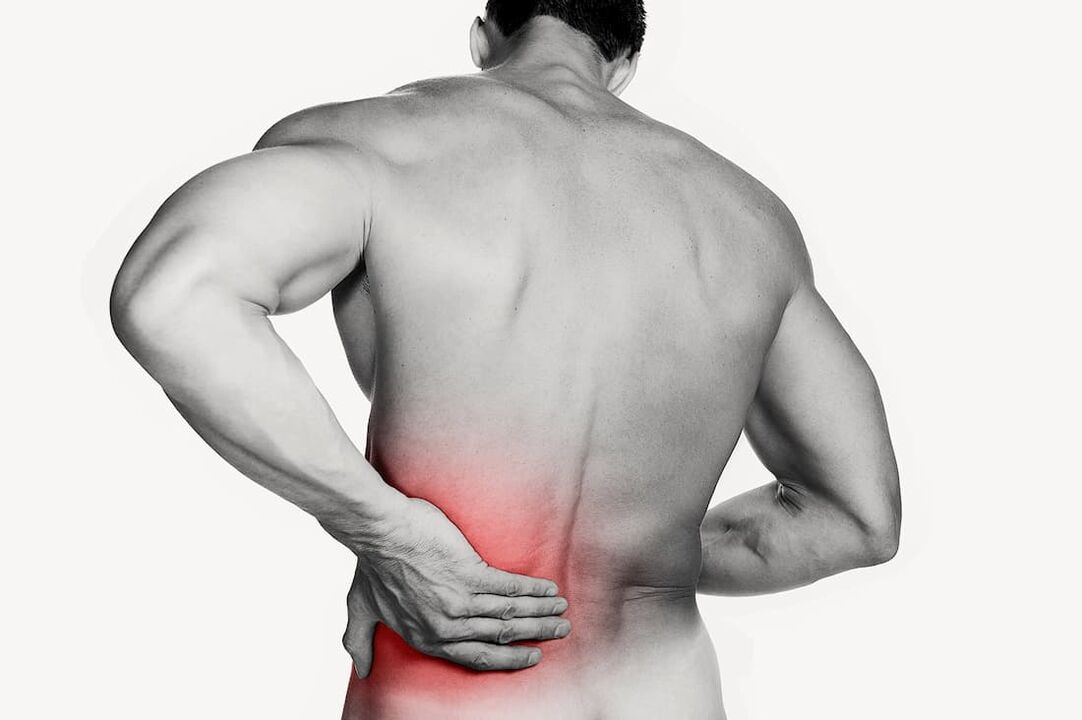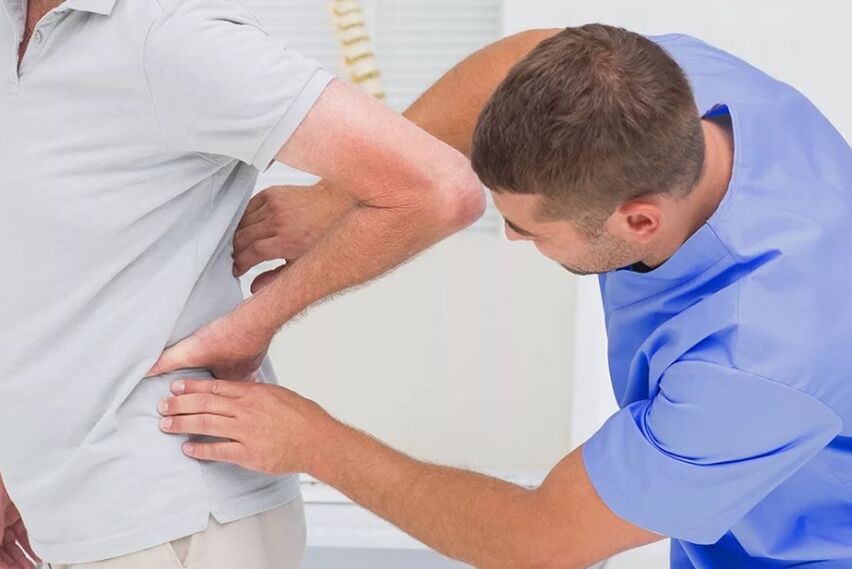
Low pain is the symptom that is rarely paid.Most people associate it with work in a sitting position, lifting weights or osteochondrosis and are not rushing to see a doctor.In fact, this condition can signal kidney, liver or intestinal diseases, and problems with the muscular -Skeletal system will not pass on their own.Only a timely inspection of a specialist and a thorough examination will help identify the cause of the pain and the choice of proper treatment.
General information
The lower back is an area that experiences a considerable load due to being in a straight position.The spinal column is represented by five large beads, which are also strengthened by the muscle frame.9 out of 10 cases of pain in this area are provoked precisely by the pathology of the muscular -skeletal system: osteochondrosis, muscle spasms, intervertebral disc herniation, nerve root pinch.
10% of remaining cases are associated with diseases of the internal organs located in the lower back projection: kidneys, genitourinary system, intestines, liver.Even a doctor, when examined, cannot always determine the cause of the pain, which is why this condition requires a complete laboratory and instrumental diagnosis.
Types of pain
The first thing the doctor asks is the nature of the sensations.Depending on the cause that caused it, back pain may be:
- Acute: usually arises significantly, characterized by high intensity;The duration of the sensations is not more than 1.5 months;
- Subacute: lasts 6-12 weeks;
- Chronic: sensations of any intensity lasting 12 weeks or more;
- Transfer (variable): appears periodically;
- pain;
- dumb
- Strong, medium, weak intensity.
This division is conditional.Depending on the situation and circumstances, the nature and duration of the sensations may vary.It is important to describe them as fully as possible.
Reason
The reasons why the spine begins to damage to the lower back.Most often, provocative factors serve:
- hypothermia;
- lifting weight;
- Uneven distribution of load (against the backdrop of pregnancy, behavioral disorders, muscle -skeletal system pathology);
- infectious lesions;
- Diseases of the musculoskeletal system;
- inflammatory processes, including autoimmune;
- long stay in an unpleasant position;
- change in bone tissue composition (osteoporosis);
- Volume processes: benign and malignant tumors, abscesses;
- hormonal changes (menstruation, pregnancy, menopause);
- Kidney disease (urolithiasis, pyelonephritis, glomerulonephritis, abscesses);
- Pathology of the gastrointestinal tract;
- Uterine diseases and supplements in women, prostate in men, etc.
DISEASES
Low pain can be a symptom of various diseases of the muscular system and internal organs.The doctor's main task is to find out what caused exactly the deterioration of the condition and take the necessary measures.
Here are the pathologies that are more common.
Ankylosing spondylit
It is a systemic inflammatory disease, in which individual beads occur in a single conglomerate.At the same time, calcium deposits in the ligaments that stabilize the spine occur, as a result of which the affected area almost completely loses mobility.
The distinctive characteristics of the lower back pain with ankylosing spondylitis include:
- an increase in the intensity at rest, especially with prolonged findings in a horizontal position;
- restriction of movements in the Lumbar region;
Osteochondrosis of the spine
It is a very common disease, in which the interrupted discs are thinner, performing the role of shock absorbers.As a result, nerve roots and surrounding muscle cramps that cause severe pain are irritated.At the late stage of the disease, a hernia of the intervertebral disc is formed, which can suppress the spinal cord, increasing the pain.
With osteochondrosis, the pain intensifies:
- when rising from a sedentary or horizontal position;
- when you try to lie down in your stomach;
- With inclination.
If the disease causes the formation of a mass hernia, the pain in the lower back is often associated with numbness and weakness of one or two legs.
Curve of the spine in the lumbar region (kyfosis, scoliosis)
Pain in this pathology occurs in the middle and late stages of the development of the disease.Sicleton usually occurs by the end of the day and is often associated with the fatigue of the spinal muscles.The pain is most often caused by the cramping of the spine muscles, and it is also possible to explore the muscles in the removal (gluteal, periosenantal muscles of the upper and lower extremities).
Spondillartrosis
It is a degenerative-district disease of the cartilage, which covers intervertebral discs.It is gradually thinner and destroyed, bone growths (osteophytes) appear around the lesion area.As a result of a decrease in the distance between the vertebrae, the narrow spinal canal, the nerve roots and the spinal cord irritated.
Pain with this pathology:
- Intensifies after load (long -term stay in a standing position, walking) and passes after rest;
- associated with stiffness of movements, first in the morning, then constant;
- It can be given to the thigh and hip node area.
The muscles in the lesion area are spasmodic and constantly in tension, which also increases the pain.
Uroline
An attack of urolithiasis is characterized by severe lumbar pain from the affected kidney.At the same time, the sensations do not vary depending on the position, a person cannot find a position in which they at least slightly weaken.The attack is often associated with a decrease in the amount of urine and a change in its reddish color.
Low pain can also be a consequence:
- algomena (painful menstruation);
- pregnancy;
- inflammation of the pancreas;
- osteomyelitis;
- intestinal obstruction;
- appendicitis, etc.
Pain in different parts of the back
Localization of pain can mean a lot for their cause.Pain in the upper part of the lumbar region may be a consequence:
- Spinal diseases;
- injuries;
- muscular spasm against the backdrop of their overlap;
- Cardiovascular disease;
- tumors;
- Diseases of the gastrointestinal tract.
If the epicenter is located at the bottom of the lower back, the list of possible reasons includes, in addition to spinal diseases:
- Kidney pathology (pyelonephritis, urolithiasis);
- intestinal disruption (constipation, flat);
- spasms or inflammatory process in the pelvic organs (salpingoophorite, endometritis);
- Physiological causes, in particular, pregnancy;
- Pinching sciatica.
The relocation of the pain to the right or to the left may indicate the spinal cord lesion of the spinal cord, the kidneys.
Troubleshooting
Diagnosis of back pain requires a comprehensive examination.The first stage of searching for reason is the survey.The doctor explains:
- Localization of pain;
- its character and duration;
- causes that cause an attack or increase the pain;
- Circumstances in which the condition improves (a certain position, immobility, drug intake, etc.).
Data on injuries and diseases, chronic pathologies identified are already collected without failing.Another possible diagnostic search at the doctor's discretion includes:
- General blood test and urine: helps identify the inflammatory process in the body, kidney pathology;
- Biochemical blood test to identify signs of kidney damage, pancreas, liver and gall bladder, etc.;
- Ultrasound of the abdominal and pelvis organs in men - ultrasound of the prostate gland;
- Kidney ultrasound;
- Radiography, CT or MRI of the middle back;
- X -Ray of clues.
In case of suspicion of any pathology after a diagnosis and review inspection, more intended tests, examinations and consultations of close specialists shall be determined.They allow you to clarify or reject the diagnosis.

Treatment
The treatment of pain in the lower back depends on its cause.A neurologist, a urologist, a gynecologist and a surgeon can be included in a pathology.If we are talking about diseases of the muscular system, doctors use medical, non-medicinal and surgical methods to improve the patient's condition.
Treatment
The most common tool to eliminate lumbar pain are non -steroidal anti -inflammatory drugs (NSAIDs).They are prescribed in the form of tablets, intravenous and intramuscular injections, rectum suppositories, as well as lotions, ointments and plaster for local use.The decision on the dose of the product, as well as the duration of the course, is taken by the doctor, as the uncontrolled use of these medicines can cause unpleasant side effects.
If NSAIDs are ineffective, doctors prescribe hormone (corticosteroids).They also stop the inflammatory process and help reduce the pain.
The third group of medicines that improve the patient's condition is antispasmodics.They remove muscle cramps in the lower back.
Moreover, they can be named:
- decongestants to reduce edema of a cut root;
- B vitamins to improve nerve tracking;
- sedatives.
Methods No -DRUG
Treatment not -drug complements medicinal schemes.Depending on the clinical situation, it may include:
- physiotherapeutic procedures (magnetotherapy, laser effect, electrophoresis, etc.);
- Physiotherapy exercises: the course of exercise develops individually in accordance with major and related diseases;Gymnastics should be performed regularly, not only in the clinic office, but also at home, only in this case it has an effect;
- general strengthening and therapeutic massage (performed outside the irritation);
- acupuncture;
- Manual therapy and assistance to osteopaths.
Surgical treatment
The surgeon's help is needed if the doctor who participates on the basis of the general figure detects one of the indications for surgical treatment.The presence of an intervertebral disc hernia is not an indicator for surgical treatment, regardless of its size.Depending on the indications, doctors can remove the intervertebral disc herniation, eliminate the compression of the spinal cord roots, remove the tumor, etc.The decision to perform a special operation is done individually.
PREVENTION
The most effective way to prevent back pain is to adjust your lifestyle in order to save the kidneys, spine and pelvic organs, but if birth often was born, this should be the reason for a tremendous attraction to a specialist:
- Avoid hypothermia;
- Prevent hypodynamine;
- Play sports at an amateur level (swimming is particularly useful affects the condition of the back and back muscles);
- Correctly and balanced to eat: prevent overeating, minimizing fatty, spicy, highly salty food;
- exclude alcohol and nicotine;
- Drink at least 1.5 liters of clean water daily no matter the tea, coffee or juices;
- Keep the body mass index at a normal level: excess weight does not affect the condition of the spine, and the deficiency can cause the kidneys to be honored.
If a person has already diagnosed the pathology of the muscular system, preferably at least twice a year, according to European recommendations for the rehabilitation of spinal pathology, to undergo preventive courses in accordance with the appointment of a physician.






















